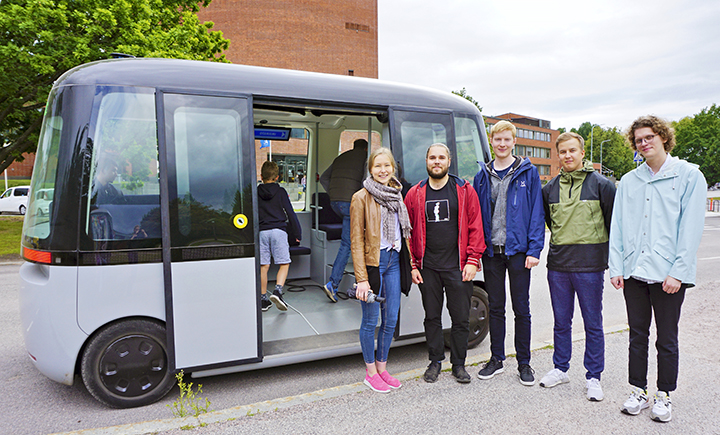
A joint project between a Finnish and Japanese company created the autonomous GACHA bus, which is intended to eventually replace public transport in Aalto University’s campus areas and in smaller residential areas. The futuristic design of the bus was created by MUJI, a Japanese company, while the technical implementation is the work of Sensible4, a company based in Espoo.
At the moment, the bus is serving a test route in Otaniemi, starting at Aalto University’s Undergraduate Centre and travelling around one kilometre along the Otakaari road before going back the same way. The journey takes about 10 minutes, depending on the traffic and roadworks, but the bus is getting faster every day.
Surprisingly, the bus is not quite as autonomous as one may be given to expect. The route must be specified beforehand, and the bus is not capable of taking to the streets automatically. Roadworks have just begun along the defined route, so a driver needs to take control for this stretch of the journey.
The bus is also not yet capable of reading road signs, lane markings or traffic lights. It is designed to travel along its route irrespective of the weather conditions and to operate with smarter traffic lights that send information to the bus about their status.
The journey by bus is pleasant: the seats are comfortable, and the bumps in the road are not an issue. The bus tends to brake sharply, so students have to be careful not to spill their coffees as the vehicle comes to a stop. However, it is comforting to know that the bus would stop immediately if a student happened to step out in front of it. This has been tested.
The autonomous bus project began in autumn 2017, and the first test drives took place in Otaniemi in Spring 2019. The project was piloted using smaller vehicles in various parts of Otaniemi before the present bus model was selected. Now, GACHA aims to test-drive the self-driving vehicle in three other parts of Finland. The project aims to replace public transport by 2020, but its progress depends on external financing. However, having experienced the bus first-hand, it is difficult to believe that a vehicle of this type will be zipping around bustling cities within a year.
GACHA self-driving bus:
- Seven Nissan Leaf batteries providing a total of 25 kWh
- Four-wheel drive electric vehicle
- Top speed as designed in autonomous operation: 40 km/h. Current top speed in practice: 20 km/h. Technical top speed: 100 km/h.
- Battery life, depending on conditions, around 3–4 hours
- Range as stated by the manufacturer: over 100 km
- Capacity: 10 seated and 6 standing
- Equipped with five cameras, Lidar, GPS, an inertia meter and a 4G LTE/5G connection
- At present, development is only being held back by the amount of programming required rather than the physical construction of the vehicle







